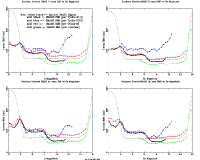
i. Quality of 2MASS Positions
Comparison of the 2MASS catalog with a variety of other catalogs indicate that 2MASS positions in the International Celestial Reference System (ICRS) are accurate (in-scan and cross-scan, separately) to 70-80 mas (RMS) over most of the magnitude range, far better than the Level 1 requirement of 500 mas. This conclusion is based on comparisons of positions and uncertainties with the Tycho-2 and UCACr10 catalogs, as well as from 2MASS scan overlap data. These catalogs will herein be referred to as the "comparison catalogs" (CCat). For details of these comparisons, the reader is referred to the 2MASS:Tycho-2 and 2MASS:UCACr10 comparisons, as well as a consistent independent UCACr10:2MASS comparison by Norbert Zacharias of the U.S. Naval Observatory. The stated accuracy can be demonstrated by a single figure, Figure 1, which shows a set of derived 2MASS RMS values as a function of Ks magnitude.

|
| Figure 1 |
(Each of the four panels in Figure 1 will appear when the reader clicks on the corresponding region of the figure "thumbnail" above.)
First, consider what is meant by a "derived 2MASS RMS".
Since the comparison catalogs (Tycho-2 and UCACr10) also have errors
their contribution to the RMS of the 2MASS:CCat, differences needs to be
removed to obtain a measure of the
2MASS RMS. The "derived 2MASS RMS" values are obtained by subtracting in
quadrature the mean quoted
comparison catalog  from the 2MASS:CCat difference
RMS value computed for each bin. Since the
quality of the Tycho-2 astrometry for stars previously included in Tycho-1
[referred herein as Tycho-2(1)] are considerably better than those which were
not [Tycho-2(2)], they are considered separately.
Note that an underestimate of comparison catalog errors results in an
overestimate of the 2MASS RMS and vice versa.
The 2MASS overlap differences were divided by two before the RMS values were
computed.
This assumes the two positions are independent and will tend to underestimate
the RMS, if they are not.
from the 2MASS:CCat difference
RMS value computed for each bin. Since the
quality of the Tycho-2 astrometry for stars previously included in Tycho-1
[referred herein as Tycho-2(1)] are considerably better than those which were
not [Tycho-2(2)], they are considered separately.
Note that an underestimate of comparison catalog errors results in an
overestimate of the 2MASS RMS and vice versa.
The 2MASS overlap differences were divided by two before the RMS values were
computed.
This assumes the two positions are independent and will tend to underestimate
the RMS, if they are not.
In Figure 1 data taken from the northern
facility are presented in
the left panels, and from the southern facility in the right panels.
Cross-scan results can be found in the upper panels and in-scan in the lower.
In each of the four panels
2MASS RMS values derived from 2MASS differences with Tycho-2(1)
(solid black),
Tycho-2(2) (solid blue), UCACr10 (solid red), and scan overlaps
(solid green) are shown.
For comparison, the mean quoted 2MASS  is shown
as a dotted black line.
is shown
as a dotted black line.
With the notable exception of the Tycho-2(2) results, these form a reasonably consistent set of measurements. The UCACr10-derived 2MASS RMS values tend to be somewhat higher that the Tycho-2(1)-derived values. A certain amount of that difference might be expected, since the Tycho-2(1) was the primary reference for the 2MASS reconstruction, and the UCACr10 was not used at all. Given that the overlap positions are not totally independent, the overlap RMS values can be expected to be low. But since any correlations between overlapping scans are not expected to be magnitude dependent, the change in overlap-derived 2MASS RMS with magnitude, however, is meaningful. Raising the overlap-derived curve up to between the Tycho-2(1)- and UCACr10-derived curves should provide a fair measure of how fast the 2MASS RMS climbs after Ks=15 mag, where other comparison catalog data are not available. Given the discrepancy of Tycho-2(2)-derived 2MASS RMS values with all other measures, the most likely explanation is that the Tycho-2(2) quoted errors are underestimated. As can be seen in the 2MASS:Tycho-2 comparison, there are no significant systematic differences between Tycho-2(1) and Tycho-2(2).
ii. Quality of 2MASS Uncertainties
Comparing the mean quoted 2MASS  (dotted black line) to the derived 2MASS RMS values in
Figure 1 and ignoring the Tycho-2(2) data
(solid blue line), it can be seen that the
quoted 2MASS
(dotted black line) to the derived 2MASS RMS values in
Figure 1 and ignoring the Tycho-2(2) data
(solid blue line), it can be seen that the
quoted 2MASS  track reasonably well, except at the
bright (Read_1) end. For Ks magnitudes between
4.0 and 8.5 (typically unsaturated Read_1) the quoted 2MASS
track reasonably well, except at the
bright (Read_1) end. For Ks magnitudes between
4.0 and 8.5 (typically unsaturated Read_1) the quoted 2MASS
 are too low, but for
brighter magnitudes (typically saturated Read_1) they are very conservative.
are too low, but for
brighter magnitudes (typically saturated Read_1) they are very conservative.
Although of lesser amplitude (2MASS RMS < 100 mas) than the magnitude dependence, the detailed comparisons referred to earlier also show an increase in 2MASS errors hear the poles and very near scan edges.
[Last updated: 2003 Feb 10; by H. McCallon]